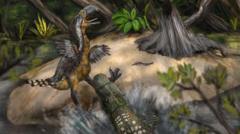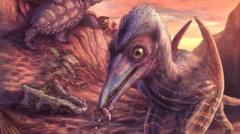In an extraordinary discovery, scientists have uncovered evidence suggesting that a large, flightless avian predator known as a terror bird met its demise 13 million years ago after an encounter with a massive caiman. This revelation comes from meticulous research analyzing teeth imprints found on the fossilized leg bone of the terror bird retrieved from Colombia's Tatacoa Desert. The researchers utilized advanced 3D digital scanning techniques to meticulously compare the size and shape of these bite marks with the known skulls and teeth from various crocodile-like reptiles.
The terror bird, which stood about 2.5 meters tall, was a formidable predator of its time. Its fierce legs and sharp, hooked beak allowed it to dominate its environment. However, the finding of teeth marks on its leg bone suggests a surprising vulnerability, as this ancient bird likely fell victim to an even larger predator – the caiman, specifically the extinct species Purussaurus neivensis, which could grow up to five meters in length and ambushed its prey from water edges.
Prior to this research, the leg bone had been sitting in a museum for over 15 years since its discovery by local fossil collector César Augusto Perdomo, who collaborated closely with the research team. The team’s analysis revealed that the absence of healing around the bite marks implies the terror bird did not survive the encounter, pointing towards a dramatic end likely captured in an ancient ecosystem’s food chain.
Lead researcher Andres Link from the Universidad de Los Andes emphasizes the significance of this find, suggesting it offers a glimpse into the dynamics of prehistoric life. The study not only highlights the fierce nature of these apex predators but also underscores their vulnerabilities, contributing to the broader understanding of ancient ecosystems and the interactions between species. With every fossil studied, scientists weave together narratives of past life, turning seemingly small discoveries into essential pieces of history.
The terror bird, which stood about 2.5 meters tall, was a formidable predator of its time. Its fierce legs and sharp, hooked beak allowed it to dominate its environment. However, the finding of teeth marks on its leg bone suggests a surprising vulnerability, as this ancient bird likely fell victim to an even larger predator – the caiman, specifically the extinct species Purussaurus neivensis, which could grow up to five meters in length and ambushed its prey from water edges.
Prior to this research, the leg bone had been sitting in a museum for over 15 years since its discovery by local fossil collector César Augusto Perdomo, who collaborated closely with the research team. The team’s analysis revealed that the absence of healing around the bite marks implies the terror bird did not survive the encounter, pointing towards a dramatic end likely captured in an ancient ecosystem’s food chain.
Lead researcher Andres Link from the Universidad de Los Andes emphasizes the significance of this find, suggesting it offers a glimpse into the dynamics of prehistoric life. The study not only highlights the fierce nature of these apex predators but also underscores their vulnerabilities, contributing to the broader understanding of ancient ecosystems and the interactions between species. With every fossil studied, scientists weave together narratives of past life, turning seemingly small discoveries into essential pieces of history.


















